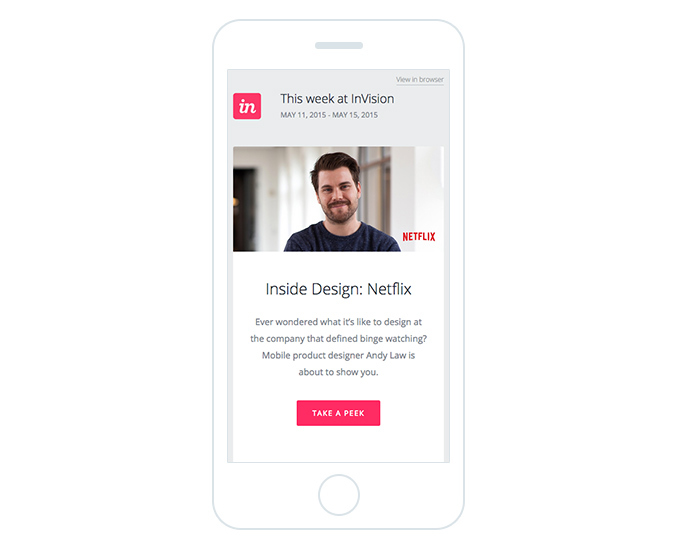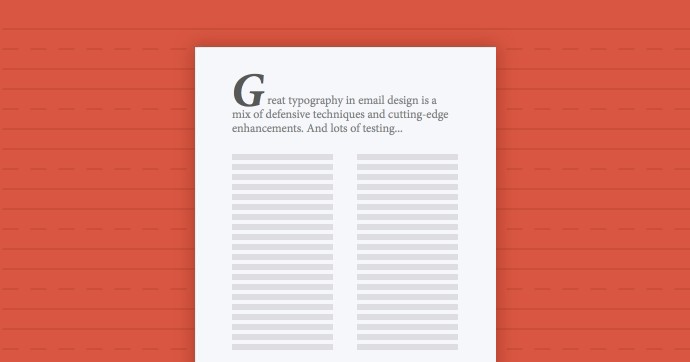7 simple tips for optimizing emails for mobile devices
Subscribers view more than half of all mailing lists on mobile devices. Therefore, to impose these messages so that they were easy to read on a small screen is simply necessary. Today we will look at some simple tips for creating mobile-friendly emails.
Between 2010 and 2015, the number of emails opened on mobile devices increased by 30%:

')
If the letters that companies send to subscribers are not optimized for viewing on small screens, then a significant portion of the audience simply will not read them and will be lost. And how can this be avoided.
Usually, the email client on the desktop displays about 60 characters in the subject field of the message, but mobile devices show no more than 25-30 characters. In this case, some studies show that on average, companies use topics longer than 40 characters.
First of all, you need to understand what percentage of subscribers will read them on mobile devices - so you can choose the optimal length of the topic. This can be done using the reporting module of most services for creating mailings.

If the report shows that there is a large number of mobile device users among subscribers, you should reduce the topic to a length that will be well displayed on small screens.
The text of the preview (preheader) of letters is often ignored and completely in vain, since it can be an excellent tool for creating mobile-friendly mail letters. A preheader is the first line of the text of the letter, which “pulls up” in the line under the subject, and allows the subscriber to understand what the message will be about.
Below is a screenshot of the mail application Gmail for iPhone 6. The text of the preview is displayed in gray. With it, the user can understand what awaits him after opening the letter.

We published material on working with the text of the preview and the support of this technology by various mail programs.
When creating letters, adapted for viewing on mobile devices, it is very important to get away from the "sheets" of the text. It should be easy to skim through the view, which helps the use of lists and short paragraphs.
The small screen size of mobile devices can help the user to read the letter while doing something else. Therefore, it is important to convey as clearly as possible the key points of the message and highlight calls to action (for example, using buttons).

This material contains tips on creating effective plain-text letters - they can be used when working with text for mobile-friendly messages.
Many (and not only mobile) email clients by default block the display of pictures. Therefore, it is necessary to take care that the “plot” of the letter is clear to the subscriber and without images. You can do this by using alt-text (more on this in our past topic ):

Since the recipients of the letter are unlikely to have a large amount of time to read it, they must be made so that they can easily understand what is required of them and how they can achieve what they want. This means that calls to action must be highlighted and located in the center of the screen - it’s easier to get a finger on them. Buttons should be made at least 44x44 pixels.

It is more difficult to click (tap) on a mobile device than on a desktop. You need to leave subscribers enough space to click on the desired part of the letter with your finger. The buttons should be surrounded by a significant amount of empty space, and the font of the text and links should not be the smallest (we wrote here about working with typography in email design).

Before sending a newsletter, you need to test it on different devices to make sure that email applications display messages normally. There are quite a lot of mobile clients, and each of them can conceal their own surprises.

In addition, you should experiment with other message parameters, such as the time and day of dispatch. More information about other important statistics on Runet can be found in our material .
Why is this important at all?
Between 2010 and 2015, the number of emails opened on mobile devices increased by 30%:

')
If the letters that companies send to subscribers are not optimized for viewing on small screens, then a significant portion of the audience simply will not read them and will be lost. And how can this be avoided.
It is important to keep track of the length of the letter.
Usually, the email client on the desktop displays about 60 characters in the subject field of the message, but mobile devices show no more than 25-30 characters. In this case, some studies show that on average, companies use topics longer than 40 characters.
First of all, you need to understand what percentage of subscribers will read them on mobile devices - so you can choose the optimal length of the topic. This can be done using the reporting module of most services for creating mailings.

If the report shows that there is a large number of mobile device users among subscribers, you should reduce the topic to a length that will be well displayed on small screens.
Preheader text should be used.
The text of the preview (preheader) of letters is often ignored and completely in vain, since it can be an excellent tool for creating mobile-friendly mail letters. A preheader is the first line of the text of the letter, which “pulls up” in the line under the subject, and allows the subscriber to understand what the message will be about.
Below is a screenshot of the mail application Gmail for iPhone 6. The text of the preview is displayed in gray. With it, the user can understand what awaits him after opening the letter.

We published material on working with the text of the preview and the support of this technology by various mail programs.
The text should be short and clear.
When creating letters, adapted for viewing on mobile devices, it is very important to get away from the "sheets" of the text. It should be easy to skim through the view, which helps the use of lists and short paragraphs.
The small screen size of mobile devices can help the user to read the letter while doing something else. Therefore, it is important to convey as clearly as possible the key points of the message and highlight calls to action (for example, using buttons).

This material contains tips on creating effective plain-text letters - they can be used when working with text for mobile-friendly messages.
Need a plan B for disabled images
Many (and not only mobile) email clients by default block the display of pictures. Therefore, it is necessary to take care that the “plot” of the letter is clear to the subscriber and without images. You can do this by using alt-text (more on this in our past topic ):

Calls to action must be visible and centered
Since the recipients of the letter are unlikely to have a large amount of time to read it, they must be made so that they can easily understand what is required of them and how they can achieve what they want. This means that calls to action must be highlighted and located in the center of the screen - it’s easier to get a finger on them. Buttons should be made at least 44x44 pixels.

Need to leave more space
It is more difficult to click (tap) on a mobile device than on a desktop. You need to leave subscribers enough space to click on the desired part of the letter with your finger. The buttons should be surrounded by a significant amount of empty space, and the font of the text and links should not be the smallest (we wrote here about working with typography in email design).

You need to test the letter on different devices
Before sending a newsletter, you need to test it on different devices to make sure that email applications display messages normally. There are quite a lot of mobile clients, and each of them can conceal their own surprises.

In addition, you should experiment with other message parameters, such as the time and day of dispatch. More information about other important statistics on Runet can be found in our material .
Source: https://habr.com/ru/post/263189/
All Articles